Using an IRRI axial flow thresher
Before operating the thresher
|
Positioning of the thresher
|
|
Check the machine
|
|
|
|
|
Operating the thresher
Three to four persons are needed for operation: One or two persons to load the feed tray, one operator who feeds the machine, one person for bagging.
|
|
|
|
Optimizing thresher operation
- Long straw: briefly hold the crop bundles at the feed opening for partial threshing. Longer cut material reduces machine output and may result in poor threshing and clogging of the machine.
- Short straw: Recycling the straw if necessary unthreshed loss is high. Panicle-harvested materials (cutting just above the flag leaf) may result in high unthreshed losses because the panicles move rapidly through the thresher without receiving sufficient threshing.
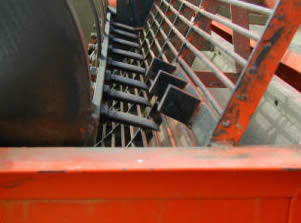 Hard to thresh varieties: Install stripper bars. The stripper bars prevent straw from wrapping around the cylinder and aid in threshing. Use of stripper bars reduces capacity and increases the amount of finely chopped straw that passes through the concave when threshing overly mature crops, thus they should be installed only when necessary.
Hard to thresh varieties: Install stripper bars. The stripper bars prevent straw from wrapping around the cylinder and aid in threshing. Use of stripper bars reduces capacity and increases the amount of finely chopped straw that passes through the concave when threshing overly mature crops, thus they should be installed only when necessary.
- Wet or partially decomposed crop: Reduce feeding rate to avoid overloading. Ensures that the cleaning screen is kept free of clinging straw. Open the cylinder cover periodically to remove straw and chaff accumulation at the lower concave
Maintenance and service
- Lubricate cylinder and fan bearings with a good-quality general purpose grease every 25 hours of operation. Periodically apply a small amount of oil to all hinge points.
- Inspect the machine regularly for loose, worn, or damaged pegteeth, concave bars, cylinder, discharge paddles and other parts, and tighten, repair, or replace them immediately. Missing bolts or nuts must also be replaced.
- Reduce belt tensions by loosening the idler pulley and engine mounting bolts when the machine will not be used for an extended period to minimize deterioration.
- Check engine crankcase oil level at least every 4 operating hours and follow the engine manufacturer's recommendations for oil change intervals and oil grade. Be sure the recommended oil level is maintained.
- Service the air cleaner, fuel filter, fuel line, carburetor, and spark plug regularly according to engine manufacturer's instructions.
Storage of a threshing machine
- Clean the machine thoroughly.
- Remove belts and store in a dry place.
- Store the machine in a clean, dry location and cover to reduce damage from dust accumulation.
- Paint parts that need repainting.
- Clean and apply oil to exposed metal surfaces to prevent rusting.
- Follow the manufacturer's recommendations on engine storage
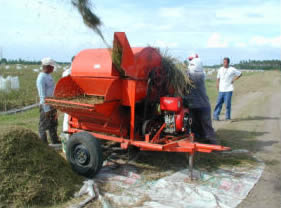 Position the thresher on a level area close to the crop stack to minimize handling and shattering losses.
Position the thresher on a level area close to the crop stack to minimize handling and shattering losses.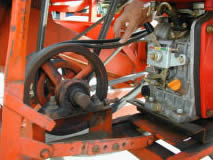 Check each belt's alignment and tension. Adjust the idler pulley on the blower/cylinder belt to correct tension. Improper alignment and tension are the major causes of premature belt failure.
Check each belt's alignment and tension. Adjust the idler pulley on the blower/cylinder belt to correct tension. Improper alignment and tension are the major causes of premature belt failure.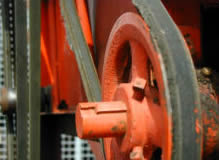 Check pulley surfaces. Rough grooves must be smoothened with a fine file if nicked. Cracked pulleys should be replaced immediately.
Check pulley surfaces. Rough grooves must be smoothened with a fine file if nicked. Cracked pulleys should be replaced immediately.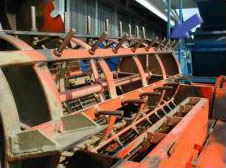 Open the cover and check all pegs on the threshing cylinder for tightness. Loose pegs will damage the machine and can be dangerous to the operators.
Open the cover and check all pegs on the threshing cylinder for tightness. Loose pegs will damage the machine and can be dangerous to the operators.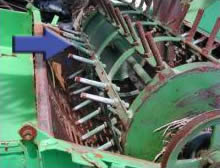 Examine the pegteeth for wear. Maximum wear occurs at the feed end of the cylinder and is more prominent at the leading side in the direction of rotation. Worn pegs must be rotated 180 degrees or interchanged with those located near the straw paddles. Badly worn pegs must be replaced or rebuilt by welding.
Examine the pegteeth for wear. Maximum wear occurs at the feed end of the cylinder and is more prominent at the leading side in the direction of rotation. Worn pegs must be rotated 180 degrees or interchanged with those located near the straw paddles. Badly worn pegs must be replaced or rebuilt by welding.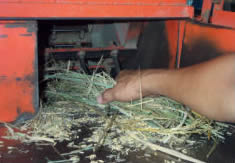 Load the feed tray with harvested crop with the panicle away from the operator, so it is fed panicle first into the thresher.
Load the feed tray with harvested crop with the panicle away from the operator, so it is fed panicle first into the thresher.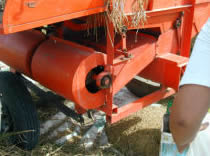 Adjust the cleaner to suit the threshing conditions.
Adjust the cleaner to suit the threshing conditions.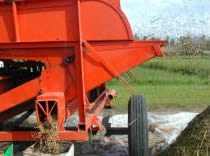 Adjust the angle of the wind-board. For dry paddy, the wind-board should be set at its maximum inclination. For threshing wet paddy, the inclination of the wind-board must be reduced. To obtain extra-clean paddy, set the wind-board at a low inclination and increase the air shutter opening. This process will blow more grain over the wind-board, but this can be recovered by recycling the separated impurities through the thresher.
Adjust the angle of the wind-board. For dry paddy, the wind-board should be set at its maximum inclination. For threshing wet paddy, the inclination of the wind-board must be reduced. To obtain extra-clean paddy, set the wind-board at a low inclination and increase the air shutter opening. This process will blow more grain over the wind-board, but this can be recovered by recycling the separated impurities through the thresher.